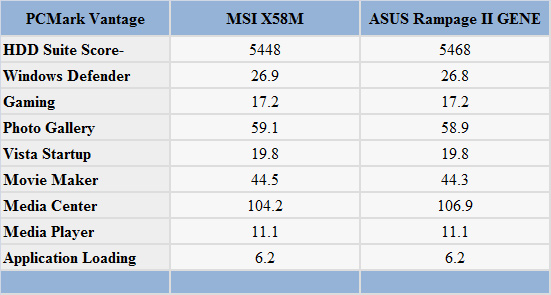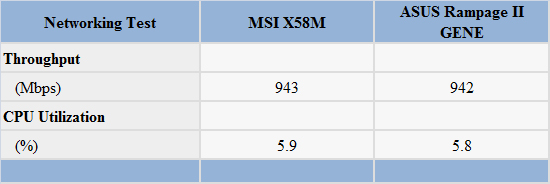Storage Performance – PCMark Vantage
PCMark Vantage is the latest system benchmark available from Futuremark, and is specific to Windows Vista and now Windows 7. Similar to the venerable PCMark05 in its makeup, Vantage modernizes the criteria and test methodology to reflect what users may encounter when running the new Windows OS and current applications. The total HDD benchmark is roughly 87% reads and 13% writes in nature. We run each test five times per drive, producing a median score that we use for comparison in our charts. We enable AHCI settings for each board and downloaded the latest Win7 driver set from Intel.

The ASUS scores slightly higher on the total suite score due to a stronger performance in the Media Center test. Otherwise, the two boards perform almost identically in the other test suites. There are no real surprises here since both boards utilized the same ICH10R and driver set on an identical drive image.
Networking Performance
The Windows 2000 Driver Development Kit (DDK) includes a useful LAN testing utility called NTttcp. We use the NTttcp tool to test Ethernet throughput and the CPU utilization of the various Ethernet Controllers used on the motherboards. We set up one machine as the server, in this test an Intel system with an Intel CSA Gigabit LAN connection. Intel CSA has a reputation for providing fast throughput and is a logical choice for our Gigabit LAN server.
On the server side, we use the following Command Line as suggested by the VIA white paper on LAN testing:
Ntttcpr -m 4,0,‹server IP› -a 4 -l 256000 -n 30000
On the client side (the motherboard under test), we use the following Command Line:
Ntttcps -m 4,0,‹client IP› -a 4 -l 256000 -n 30000
At the conclusion of the test, we capture the throughput and CPU utilization figures from the client screen.

Since both motherboards utilize the same Realtek RTL8111C controller, the results are equal for the most part.
First Thoughts
We are actually at a loss for words to be honest. At a $169.99 price tag, we expected a motherboard lacking in features compared to the more expensive X58 offerings, with average performance at best. MSI has now shown us that you do not need to spend $250~$300 for an X58 motherboard to get a full feature set along with well balanced performance. The X58M is perfectly happy operating as the foundation for a high-end SOHO SFF media system or a high performance SFF gaming system. With the right case setup, this motherboard can be the centerpiece in a killer LAN Party system - or in our case, the crown jewel for a single home system that can do everything from media creation to gaming better than any other alternative CPU/chipset combination we can think of.
Based on our original experience with the MSI X58 Eclipse and Platinum motherboards, we really did not expect much in the way of improvements in clocking or performance. You can imagine our surprise after using this board for the last two weeks. It is has proven to be a very stable motherboard with excellent performance. Do you want to boot your latest 920 D0 at 21x230? No problem, the board handles it without breaking a sweat. Do you need to overclock while keeping your CPU core Vid at less than 1.00V in load conditions? Once again, this board will handle that requirement with aplomb and offers a multitude of options to accomplish it.
Of course, not every board is perfect and this one does have a couple items that bother us. The first problem is that S3 resume does not work properly with Bclk settings above ~150 at this time. MSI is working diligently to remedy that situation but by now, this is something any X58 motherboard should handle with ease. We do not care for the placement of the two chassis fan headers as most double slot video cards will create problems with their usage. They are usable (barely at times), but it requires some forethought when installing the board and components. In addition, both of these fan headers lack proper speed and temperature controls and for a uATX board targeted to the SFF market, this is something we do not like. The PWM area requires proper air cooling in heavy overclock situations as MSI did not provide a heatsink for passive cooling.
The board tends to slightly overvolt VTT and at times VDimm, but load voltages are correct on our review sample. There are also some inconsistencies in the BIOS feature descriptions and we would have preferred tighter tRFC timings at DDR3-1333/DDR3-1600 speeds. On the pure wish list, we would like to see an additional two USB headers on the I/O panel and a nice black PCB to match the blue/black design scheme on the various connectors and slots. The overclocking Bclk switch should be replaced with a reset button or ideally both a reset button and clear CMOS button. We understand certain sacrifices have to be made to meet this price point and so our list of potential improvements does not concern us greatly, except for the S3 resume problem.
All that aside, we think MSI has a winner here. The price is right, the quality is great, performance is terrific, and the feature set (CrossFire/SLI) matches that of boards costing up to a hundred dollars more. We have no problem recommending the MSI X58M at this point and look forward to seeing it again in our roundup.










25 Comments
View All Comments
Gary Key - Monday, May 25, 2009 - link
I mentioned on page three about the IOH temperatures, up around 86C or so when overclocking and the board really needs some type of active cooling in that area for 24/7 OC settings. Those temps are still within spec but about 12C higher than the GENE board at like settings. That said, this heatsink worked better than the Platinum board from MSI.GeorgeH - Saturday, May 23, 2009 - link
Wow. With this board and one of Microcenter's $200 i7 920's, you could build yourself what is essentially a top of the line PC for next to nothing right now. It really makes me wonder what to expect from i5 - it's starting to look like it'll have to be either dirt cheap or offer >90% of i7's performance for it to be a truly interesting option.FaaR - Saturday, May 23, 2009 - link
As a happy owner of the ASUS Rampage II Gene, I really must say this looks like a great board. I know many people think the Gene's overpriced, and on some level I agree with them. I just happen to think the price I paid was worth it. ;)To those that don't like the high cost of the Gene, this board would make an excellent substitute. Heck, it's even a smidgen faster in most tests, how's that for value huh? :D Still, on the whole I prefer my Gene. It has the attention to detail where it really counts, IMO, apart from the MSI board having PCIe x4 instead of the Gene's x1 (slots which become blocked anyway as soon as a double-wide GPU is insterted in the nextdoor x16 slot, making the advantage rather moot...)
The Gene has passive cooling on the VRMs as standard, makes me breathe a bit easier with regards to the safety and longevity of the components involved. The Gene also has five WELL-PLACED fan headers (all of them of the 4-pin variety for PWM speed management). It has PCIe x16 slots with convenient little pedals to release the board in the slot, instead of those horrific pull-tabs on the MSI board which always makes me curse whenever I have to blindly dig around inside of a case to get the card out. I also really REALLY like the Gene's software X-Fi sound, the driver works great and sounds great once it's been set up.
And then there's the little power/reset/safe memory/cmos clear buttons too, for those who like stuff like that. Personally I can't really reach any of the mobo buttons once the board's mounted in my case even if the lower PCIe slot isn't housing a 2-slot GPU, but at least they're there for those who can, and they glow in soft-off mode to indicate the board has power so you don't go pulling stuff out without first shutting things off properly...
All in all, the ASUS board is a bit more polished, although at a greater cost. As is usually the case. :)
goinginstyle - Saturday, May 23, 2009 - link
Wow, somebody finally gets the fact that overclocking and Crysis is not what makes an article, although I like your overclocking results. I hope the roundup gives us more tests results like these. I thought this was a full review based on seven pages as you covered just about anything I wanted to know in this preview. Thank you for a preview that is just not pictures and press release text!danger22 - Monday, July 26, 2010 - link
does anyone know if win server 2008 x64 supports this board?